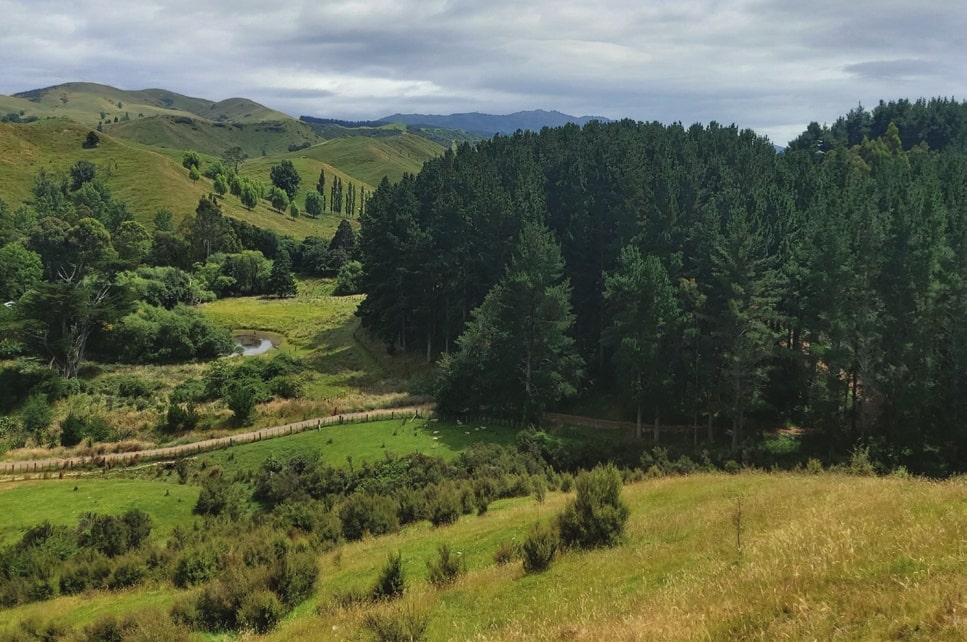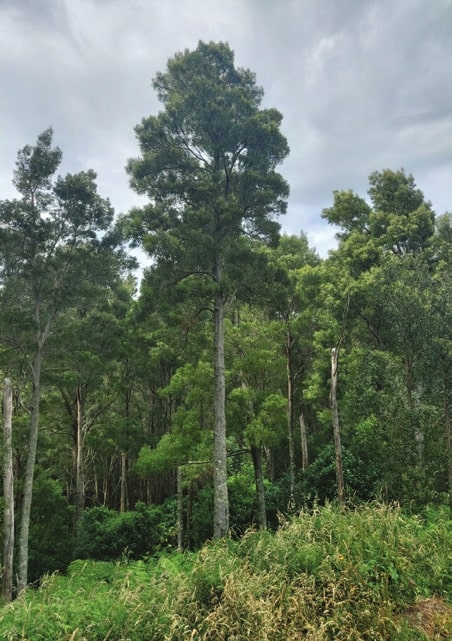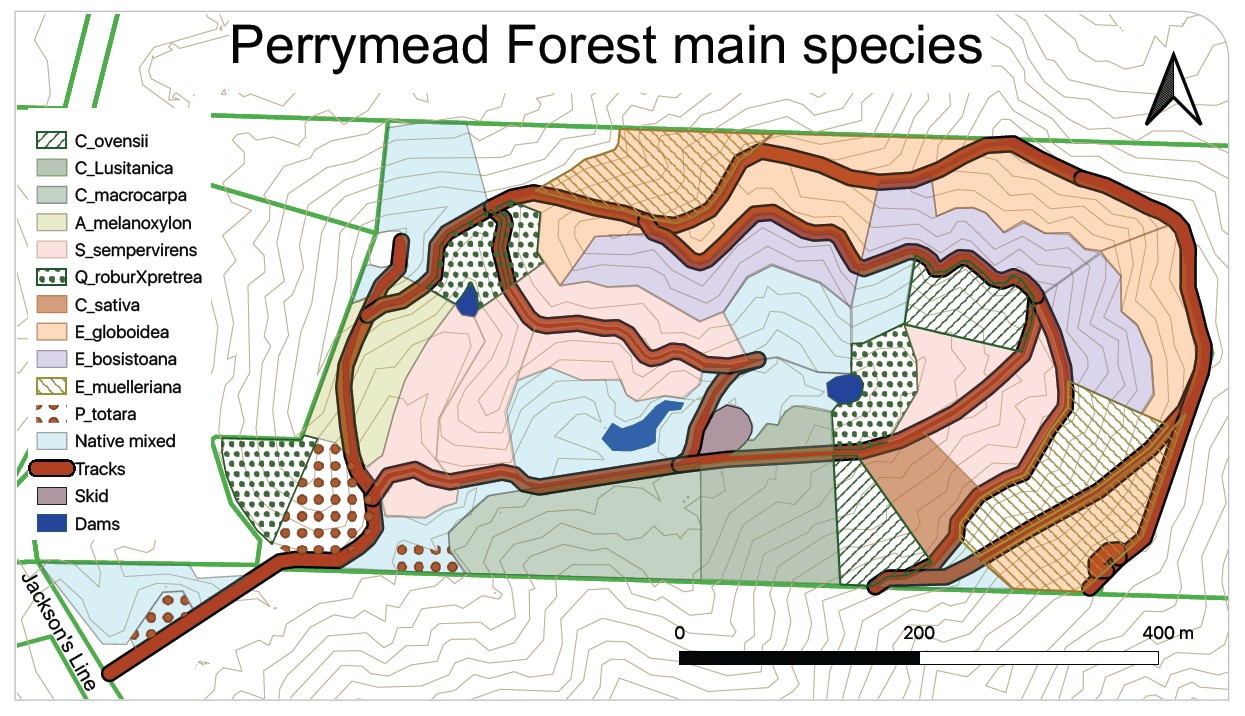Transitioning from pine to mixed species continuous cover forestry
Chris and Harry Livesey, New Zealand Tree Grower February 2021.
Chris and Harry Livesey are a father and son team. Chris planted the forest in 1993 and is planning to harvest the pine component some time in 2021. Then Harry will take over to plant and manage the replacement forest under a continuous cover harvesting regime.
Perrymead Forest is located in the Wairarapa, just over 15 kilometres north of Masterton and five kilometres south of Pukaha/Mount Bruce. It is about 20 hectares in area, at an altitude between 190 and 290 metres above sea level. Over the last 40 years the average annual rainfall has been about 1,400 mm. The prevailing wind is from the north-west and the winds, the north-westerlies and the less frequent southerlies are at times very strong.
The forest was established in 1993 with approximately 15 hectares of radiata pine and just over a hectare each of macrocarpa, lusitanica, Eucalyptus regnans and blackwood Acacia melanoxylon. A late frost killed almost all the eucalypts and that area was replanted with radiata pine in 1994. The pine was pruned and thinned to about 380 stems a hectare. The other species were also pruned and thinned although in hindsight not thinned enough. In 2010 a small area of totara was planted and is now being pruned.
Recent activities
Seven years ago a track was put in through the blackwood as access to a site for a caravan. As a result, vigorous blackwood regrowth has taken place on the open, disturbed ground all along both sides of the track. These young blackwood have excellent form and the saplings are being progressively thinned out to allow the chosen stems to get the light and space they need to produce good crowns. In the moister, more sheltered areas of the forest there is vigorous native regeneration under the pines, cypress and blackwood.
Several of the rougher macrocarpa have been felled and milled using an Alaskan mill. This has produced timber for raised garden beds for family members and for cladding on a drying shed in the forest.
Blackberry is present throughout the forest and although mainly suppressed by the current canopy, will need careful control in the harvested areas. Wilding pines will also need to be controlled following harvest. Hares are present and they nipped off many of the initial planting of blackwood and periodically a small group of deer take up residence in the forest. New planting will need protection from these animals.


Harvest planning and replanting
Planning has begun for harvesting the radiata pine in early 2021 and replanting the harvested area in the winter or spring of 2022. There is good road access and the harvest ought to be a straightforward ground based operation. Harry will be taking over the forest after the harvest of the pine. He believes that New Zealand needs a greater diversity of forestry models to match our landscapes, spread the risks involved with markets and biosecurity, and provide a range of quality forest products and livelihoods.
For land stability, water quality, biodiversity and aesthetic reasons he is not keen on clear felling for this site. He wants to help grow the supply of naturally durable timber as an alternative to treated pine. He is keen to have timber of varying colours and properties for his woodworking activities and to explore the feasibility and practicality of managing a small forest for a more regular income than clear felling a small even-aged forest.
Harry would like to add to the growing number of forests showing that models other than clear-fell radiata pine are possible and profitable. He acknowledges he may not achieve this lofty aim but he is setting out with this ambition.
To meet all these objectives the intention is to convert Perrymead Forest into a mixed species, continuous cover forest. Reading about the other farm foresters innovating with alternative species and meeting up with them for vigourous discussions has shaped the new forest plan. In particular, the experiences, advice, and encouragement of Richard Thompson, Harriet Palmer, John Wardle, Denis Hocking, Paul Millen, Rachael Rose and Hamish Randle have been invaluable.
Microsites and species selection
Perrymead Forest covers most of a small east-west oriented valley giving a range of aspects and micro-climates but very little flat land. The north facing slopes are hot, dry and exposed. The south facing slopes are cooler and slightly more sheltered, while the valley bottoms are wet and frosty.
The underlying rock is mudstone leading to fertile heavy clay soils prone to erosion. Harry spent much of his childhood getting covered from head to toe in the sticky clay when playing in slips during the time his grandparents farmed the block.

The main timber species for replanting will be durable eucalypts, redwood and cypress. The hardier eucalypts E. globoidea, E. cladocalyx, and E. sphaerocarpa will be on the hot, dry, windy ridges. Wind and warmth are mostly correlated on the block but some E. mulleriana and a few E. microcorys will be put into some warm almost sheltered spots. Eucalypts which are less wind and drought hardy, E. bosistoana, E. laevopinea and E. pilularis will be on the slightly more sheltered but cooler southern slopes. The redwoods and a cypress trial will be in the valley bottoms or lower slopes where it is wetter and sheltered, but frosty.
Continuously mixing things up
How do you fit all these different trees into 15 hectares? For most of the block the plan is to interplant two species row for row. This is partly to manage the risk of some species not thriving and partly because Harry could not make up his mind about which to plant. He also thinks there is greater scope for this sort of planting under continuous cover as all the trees do not need to reach harvest size at the same time.
A variety of oaks are planned for around the two dams, a couple of areas of totara, and planting other natives along the side of the winter-flowing stream which runs through the middle of the forest.
For the native areas the plan is to initially plant with manuka for quick canopy cover and weed suppression. Natural regeneration is good with many early successional species along with tawa and titoki plentiful in the understorey as well as the occasional totara and rewarewa. These will be helped along by later inter-planting of species such as kahikatea, pukatea and possibly a few corners of red beech, puriri and pink pine.
Getting on track
A continuous-cover forest requires a higher density of tracks than a clear-fell forest, but the tracks can be smaller and to a lesser specification as they are not required to carry logging trucks. Other continuous-cover foresters have suggested that ideally, no tree should be much more than 30 metres from an extraction track. The topography and legal boundaries of the block make this tricky. A track around the top of the ridges is an obvious route, but patches of steep and unstable soils make linking tracks across the slopes more difficult.
Somewhat ironically, establishing this mixed species, continuous cover forest will rely on a good income from the harvest of the radiata pine, as well as an intergenerational interest in the project.
When Harry takes over he will have the lusticanica, macrocarpa and blackwood to thin and grow. If it is practical, he would like to mill the thinnings and use them himself or sell them. He is also interested in exploring the potential for oil and honey from the young eucalypts and natives.
Late entry to the Emissions Trading Scheme
Perrymead Forest was rushed into the Emissions Trading Scheme in October 2020. This late pre-harvest registration was to get the forest in under the old rules so that the replanted areas would be able to earn carbon credits.
Chris had not registered the forest earlier because he knew that all credits received would have to be repaid at harvest and that it would be unwise to sell any credits before harvest as the price of credits was likely to increase rather than decrease. He also assumed that registering at the start of the second rotation would pose no problems because the first rotation was planted after 1989 and had not been in the Emissions Trading Scheme. However, due to the introduction of averaging accounting in the new rules, the Ministry for Primary Industries advised that any second rotation areas registered after the introduction of the new rules would not earn credits because a second rotation forest is deemed to already be at the long-term average carbon stock. Some gains can be made by changing species and increasing rotation length.
Stock change accounting will be available for forests registering in the new permanent forest category under the Emissions Trading Scheme. Harvesting in a less intensive fashion than clear-felling is allowed in such forests, and for Harry’s plan to plant a second rotation continuous-cover, mainly exotic forest, the new permanent forest category would probably work.
However, registration in the new permanent forest category would be three to four years away. The existing stock change rules provide greater flexibility without the 50-year ban on clear-felling which is a condition under the permanent forest category. With all the noise about banning permanent exotic forests, it was thought better to register now under the existing stock change rules.
The 27-year-old stands of cypress and blackwood will continue sequestering carbon helping to offset the carbon loss from post-harvest rotting radiata slash and roots. Sometime before 2030 we expect the forest as a whole will become a carbon sink and begin earning carbon credits. It is hoped the credits will provide a small but steady income to support managment for a long time into the future.
Chris and Harry Livesey are members of the Wellington branch of the NZFFA.

 Farm Forestry New Zealand
Farm Forestry New Zealand